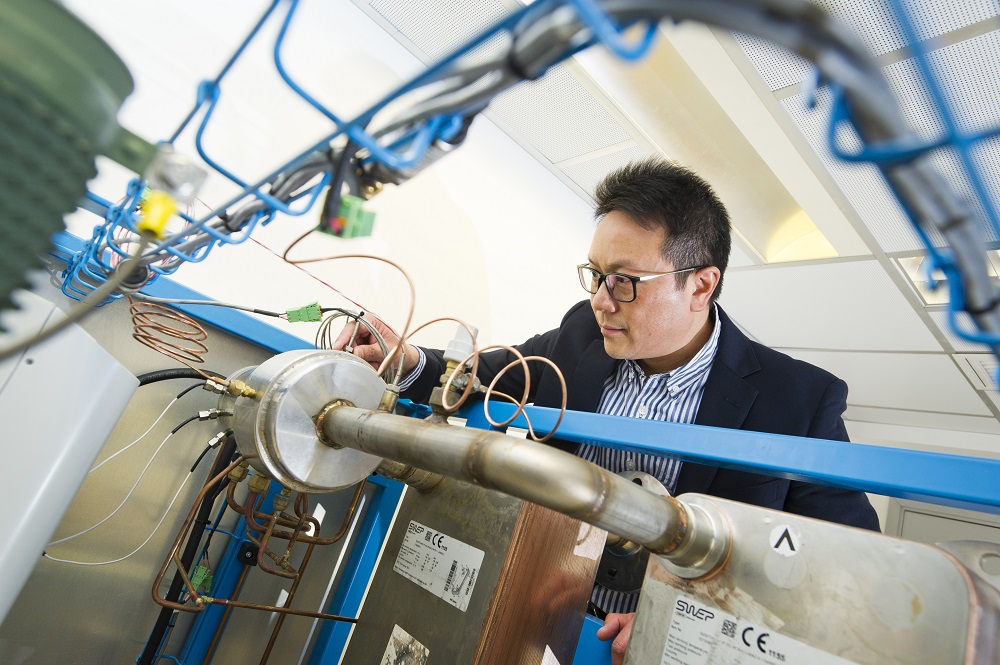Turning Waste Heat from Air-conditioners into Electricity
As the world gets hotter, the use of air-conditioners is bound to increase. But powering air-conditioning (AC) units requires energy, and the cooling process ejects heat into the surroundings, which has an adverse impact on the environment. To achieve energy-efficient cool air supply, Professor Michael Leung Kwok-hi, in the School of Energy and Environment, is developing a novel technology which efficiently converts the waste heat from AC systems into useful electricity.

“AC is often the largest energy consumer in urban cities, and demand will continue to grow because of the global urbanisation trend,” said Professor Leung, who is also the Director of the Ability R&D Energy Research Centre at CityU. “AC systems produce an enormous amount of waste energy in the form of heat and wind, resulting in the ineffective utilisation of energy resources.”
Recycling the waste heat into power is nothing new. But Professor Leung explained that the commonly used Organic Rankine Cycle (ORC) technology can work only with heat at temperatures of 200°C or above, so it cannot be applied to the heat from AC systems, which is usually 50°C to 80°C. Also, fouling contamination commonly found in AC systems results in poor indoor air quality and indirectly increases energy consumption, he added.
Recycling energy from low-temperature waste heat
Therefore, Professor Leung is developing a new generation of AC systems to recover the thermal energy from low-temperature waste heat and convert it into electricity, which can then be used by the AC unit itself, or for lighting or other electrical appliances.
The new system features the integration of thermoscience and nanotechnology, namely thermal nano technologies (TNT), to achieve high energy efficiency and clean air supply. Modelling and experimental results have shown that this TNT solution can raise the coefficient of performance (COP) of an AC system and reduce energy use up to 20%.
Professor Leung introduced that the TNT solution, which involves a number of key technologies, described as follows:
i) Ultra-low-temperature integrated organic Rankine cycle
The thermodynamics of the ORC is highly feasible for the recovery of low-temperature waste heat to generate kinetic energy. A novel refrigeration cycle, based on the integration of ORC into the conventional AC cycle, maximises the overall energy efficiency of the system.
ii) Direct thermal-charging cell
A thermo-electrochemical capacitor, made of graphene oxide based electrodes, can store thermal energy in the form of electricity. The mechanism features low-temperature heat-to-electricity conversion.
iii) Waste-heat-recovery adsorption cooling system
Innovative metal-organic framework (MOF) adsorbent materials have been developed for a modified adsorption cooling system. The application involves recovering the heat rejected by the AC system for an additional cooling effect.
iv) Nanostructured biphilic heat exchanger
A nanostructured biphilic surface is composed of superhydrophobic substrate and hydrophilic sites. As water vapour cools and condenses onto the biphilic surface, jumping droplets occur, resulting in enhanced heat transfer. This technology is applied to improve low-temperature heat recovery.
v) Forward-backward-swept vertical-axis wind turbine
For air-cooled condensers, cooling towers and exhaust air fans, the air leaving the unit at high speed is a form of waste energy. Vertical-axis wind turbines built with specially designed forward-backward-swept blades effectively capture this wind and use it to generate electricity.
The five technologies can be applied separately or they can be integrated for a synergistic effect. Professor Leung and his team are working to push the practical efficiency towards the theoretical maximum value.
“In addition to the increase in energy efficiency, the benefits include reduced greenhouse gas emissions and the reduction of unwanted waste heat rejection,” said Professor Leung. “The revolutionary technological breakthrough anticipated in this project has the potential to not only contribute to enhanced sustainability, but also generate many new business opportunities worldwide.”
This research article originated from CityU RESEARCH.